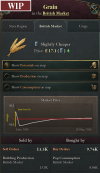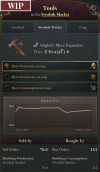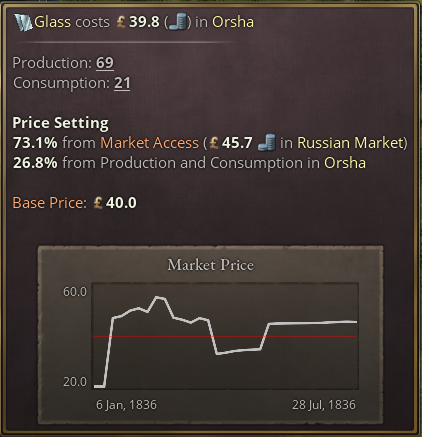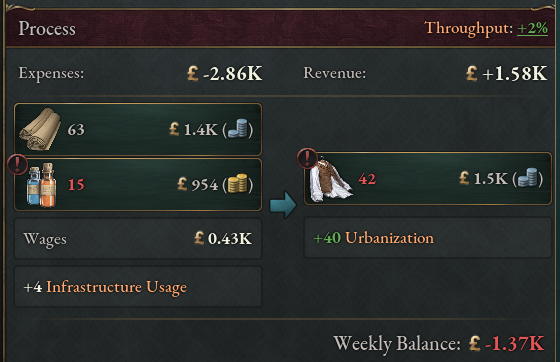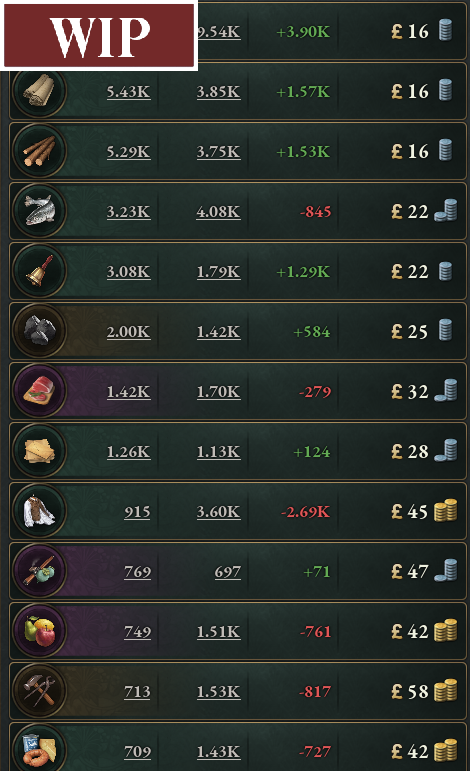
Hello again and welcome to yet another walkthrough of some interrelated systems fundamental to Victoria 3’s economic model: Standard of Living, Wealth, Pop Needs, and Consumption.
All Pops in Victoria 3 have a Standard of Living score between 1 and 99, which represents - by a perfectly scientific and objective metric, don’t @ me - precisely how great their life is. Pops with levels 1-4 are labeled Starving, levels 5-9 are Struggling, and so on through Impoverished, Middling, Secure, Prosperous, Affluent, Wealthy, Lavish, and at levels 60+, Opulent. We don’t really expect a lot of Pops to reach levels 60+ but - knowing you folks - we’ve left plenty of headroom to accommodate your mad economic experiments.
Standard of Living affects two major aspects of the game: birth- and death rate, and Pop loyalty.
Birth rate is simply the percentage of children born to Pops each year, while death rate is the percentage of Pops who die. Both values start out high and decline with increasing Standard of Living, but birth rate declines slower than death rate, leading to a net increase in population growth with increasing Standard of Living. This system models that increasing Standard of Living tends to lead to longer life expectancy but declining natality. Each parameter can be modified independently by a variety of effects.
Scratch your priesthood’s back and they’ll scratch yours. Note that Interest Group Traits can vary between Interest Group variants, so a different religion might provide a different benefit.

There are side effects to emancipation! But while reduced population growth here initially appears to be a penalty, increasing the proportion of industrial workforce at the same time tends to lead to increasing Standard of Living, which provides a net increase in population growth.

Pop loyalty is altered whenever their Standard of Living increases or declines from its current value. Martin will get into much more detail on this in next week’s Development Diary on Political Movements.
There are side effects to emancipation! But while reduced population growth here initially appears to be a penalty, increasing the proportion of industrial workforce at the same time tends to lead to increasing Standard of Living, which provides a net increase in population growth.
A Pop’s Wealth attribute forms the foundation for its Standard of Living. Pops can also gain more intangible boosts or penalties to their Standard of Living from any number of sources.
Pops accumulate Wealth over time while their weekly income exceeds their weekly expenses. Conversely, if a Pop’s expenses exceed its income, Wealth will decline. How large their expenses are depends on what and how much they consume, which is also dependent on their Wealth. What this means is that as long as a Pop’s income remains the same, and the cost of the goods and services in their state and market remains the same, that Pop’s Wealth will over time drift towards exactly the level of consumption they can afford to sustain. Of course, as Wealth changes the consumption also changes, which affects the prices of the goods in the market, which might in turn affect their wages, dividends, etcetera.
This weekly shortfall of funds will eventually lead to a reduction in Wealth and thereby consumption, but since the shortfall is only a small fraction of its income it will take several months to have an impact on the Wealth score and thereby the Standard of Living.

Wealth has a number of functions in addition to forming the basis for Standard of Living. A Pop’s raw Political Strength (excluding any such power conferred by the country’s Voting Franchise, which is treated separately) is dependent on their Wealth. Some privately operated Institutions provide benefits to Pops only in relation to their Wealth. Many Professional Qualifications also require Pops to have a certain amount of Wealth.
Each Wealth level is defined by a set of Needs and an amount of “value” that needs to be spent on goods to fulfill that Need. This “value” is defined in goods base prices, such that the Need for Standard Clothing for a Pop of size 10,000 with Wealth level 14 might be fulfilled by buying £87 worth of Clothes, assuming perfectly balanced supply and demand. If the actual price of Clothes where the Pop lives is over-demanded, their cost to fulfill this need will also be higher. As a result, cheaper goods means wealthier, happier Pops.
This Peasant Pop’s Wealth is low (6), so it consumes only the basic necessities.

Many Needs can be satisfied by a variety of different goods. For example, the Need for Heating requires Wood, Fabric, Coal, Oil, and/or Electricity. These can be purchased in any combination assuming the total base prices add up to the required value. When given this option Pops will attempt to make a rational purchase decision based on which goods are the most available, satisfying their Need with some mix of these goods or even only one, if that’s the only one available. In this way an inland, isolated state might not consume any Fish at all as long as it has sufficient Grain, Fruit, Meat, or even packaged Groceries to satisfy their Need for food.
A breakdown of how the Peasants in Ceylon spent their heating budget this week.

Goods can also appear in several different Needs categories. Groceries, Meat, and Fruit can fulfil the need for both Basic Food and Luxury Food, but Grain or Fish can only fulfil the need for Basic Food. As a result, maintaining only Millet Farms and Fishing Wharfs to meet your food needs will mostly satisfy your poor Pops, while focusing on Livestock Ranches and Banana Plantations will cause wealthy Pops to inflate the price of the available food supply and further impoverish the poor. Operating productive Food Industries that can turn Grain and Fish into Groceries is good for everyone in your country, and frees up any available supply of Meat and Fruit to be consumed by those with a Need for Luxury Food.
A breakdown of who requires Basic Food and how it can be fulfilled.

Lower Wealth levels have only a handful of Needs, such as Simple Clothing, Heating, Basic Food, and Intoxicants. The middle levels introduce more refined Needs like Household Items, Services, Luxury Drinks, and Free Movement. Really wealthy Pops consume increasingly vast quantities of Luxury Goods to impress and outdo their peers. In some cases Needs disappear entirely in favor of more diverse Needs. The Need for Simple Clothing which can be satisfied by both Fabric and Clothes will, as a Pop is raised from abject poverty, be gradually phased out by the Need for Standard Clothing which include only professionally sewn items.
Compared to the Wealth 6 Peasants, these Wealth 17 Bureaucrats are more diverse in their requirements.

Introducing new goods into your market will help you diversify your economy and alleviate the demand on crucial industrial goods. Importing Oil - either petroleum from newly discovered deposits or whale oil from the few places in the world that produce it - will cause your Pops to buy some quantity of it for heating instead of Coal or Electricity, which lowers the price of those goods and help make your industries more profitable. Introducing Opium into your market will decrease Pop demand for Liquor and Tobacco... for good or ill.
Some goods are favored over others by default if available. Once Electricity is available to them, due to its convenience Pops will prefer to buy it over Wood or Coal, even if they’re the same price. Some goods can be replaced by other goods entirely, while others will always be required to some bare minimum. Train travel can completely replace the need for having your own Automobile to drive around in, but having an Automobile doesn’t ever completely remove the need for an occasional train ride to see your cousin who lives all the way in Paris.
In addition to these factors cultures can develop Obsessions for certain goods, and some even have Taboos they must abide by. A country can also encourage or discourage the consumption of certain goods using Authority, perhaps in an effort to avoid enriching a hated enemy or entice Pops to buy something that’s heavily taxed over something that is not. This impacts the purchase habits of Pops affected despite this being irrational from a strictly financial perspective.
What if the Bengali were obsessed with the status afforded to them by Luxury Furniture? This could happen due to events, or organically because Luxury Furniture is a really prevalent luxury good in markets where a lot of Bengali Pops live. But even if this habit is developed around their homelands, Bengali Pops that migrate abroad - to the USA or Australia or Japan - will continue preferring Luxury Furniture to other luxury goods, and will suffer financially if the same level of access is not available there.

Let’s close out by considering the difference between this and the consumption model from previous games. In Victoria 2, Pops have different Life, Everyday, and Luxury Needs based on their Type (what we call Profession in Victoria 3), both in types of goods and quantities. Pops in Victoria 2 always strive to get promoted into Types which require more advanced, luxurious goods in larger quantities, but will fail to do so if they cannot afford it. Since certain advanced Types of Pops in Victoria 2 perform their duties objectively better than their less advanced counterparts (e.g. Craftsmen, Clerks) it becomes important to retain access to advanced goods in order to ensure that your workforce is internationally competitive.
In Victoria 3 this formula is turned on its head. An Engineer is not intrinsically better than a Machinist who is not intrinsically better than a Laborer, and there’s no ideal national proportions between them you need to maintain in order to maximize your competitiveness. Different Professions do fulfil different functions, but it’s the Production Methods of the Buildings they work in that determine what function they serve. By choosing what Buildings to construct and which Production Methods to activate, you create the opportunities for these Professions which in turn impose changes to the population. What types of goods you need to ensure access to in order to keep your population satisfied is not driven directly by what professional opportunities you have created, but rather by what Wealth development and Wealth distribution these changes have resulted in.
Professions that are part of the Middle Strata in this state are considerably better off than those in the Lower Strata, and not far off from the Upper Strata. It’s very likely this state hasn’t started industrializing yet, since Shopkeepers - who run the pre-industrial economy - are Middle Strata, and Upper Strata Aristocrats aren’t always particularly wealthy if their income originates from exploiting the Peasantry on Subsistence Farms. Since the Middle Strata is already wealthy enough to demand Transportation, construction of Railways in this state is likely to be both profitable and beneficial for population growth and general happiness.

As a result, Pops in Victoria 3 won’t always strive to ascend to a higher social strata, nor will an Aristocrat always have a higher income or goods consumption Needs compared to a Clerk. All of this is driven by market forces - a qualifying Clerk would gladly become an Aristocrat on available land if that comes with a higher income than remaining a Clerk, and this increased income will gradually result in an increase in their Wealth and consumption demand. Conversely, Aristocrats don’t demote to Laborers because they can't acquire enough goods to sustain their lifestyle - they would only turn to such desperate measures if they become landless (unemployed) and are trying to avoid starvation, or if by some miracle taking on a relatively well-paid Laborer job in a particularly profitable factory would actually yield a greater paycheck than their failing farm provides them with.
In practice this means that it's important in both games to secure your populations’ basic needs to prevent starvation and dissent, followed by appeasing their desire for ever more advanced or exotic goods in larger and larger quantities to increase the size of your economy and power on the world stage. But while reaching this commonly pursued end goal in Victoria 2 often meant pursuing a certain optimal population distribution no matter what else happened throughout the game, the Professions of the Pops you end up with could be vastly different between games in Victoria 3! If you build a colonial plantation economy, your Aristocrats might remain as dominant by endgame as they were at start. If you're a manufacturing powerhouse on the cutting edge of technological progress, your middle strata Pops might come to rival the Capitalist class in wealth and power. If your high taxes are reinvested in vast Institutions your power base might be dominated by Bureaucrats and Academics. If your workers own the means of production, your Laborers might even be wealthier - and consume more luxuries - than your neighbor's Aristocrats.
These possibilities for diverse Pop distributions also result in very different political tendencies in your population, which lead to demand for different kinds of Laws. While in Victoria 2 it’s primarily the rising Consciousness of a greater ratio of more advanced and literate types of Pops that drives a desire for reform in a liberal direction, Victoria 3’s more open-ended consumption model and the diversity of Professions it can create could result in your population having very different political desires by endgame depending on the path you’ve taken. This requires your political machinery to be working in tandem with your economic engine, both to create the right conditions for your Pops and to satisfy their changing desires.
Next week, we will learn more about these desires as Martin introduces us to Political Movements, which themselves are strongly connected to Standard of Living. Until then!




